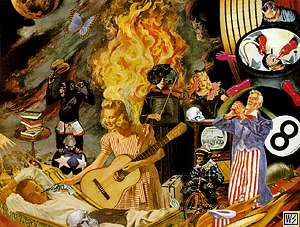
The Making Of The 'Insomniac' Cover
By artist Winston Smith.

I knew Tre when he lived up in Northern California. One day a couple years later he gave me a call and asked if I'd do a record cover for the band he was in, Green Day. Without knowing anything much about them I said, "Sure." And the next thing I knew, Tre and Billie Joe (I think Mike was out of town that day) were sitting in my studio poring over photocopies of almost everything I'd ever created. The image that grabbed them the most was the pair of figures appropriated from Jan van Eyck's Wedding Portrait of 1434, in the picture "Til Death Do Us Part".
So I used that as the nucleus for my composition. My title for the piece, "God Told Me to Skin You Alive" was a reference to a comic book-style religious tract that (Jello) Biafra and I used for the fold-out poster included with the first Dead Kennedys' album, "Fresh Fruit for Rotting Vegetables". This phrase was also Biafra's first line on side one of that album. (My cat, 911, now wears it on his collar tag...)
Bill instantly got the reference the moment I showed it to him. He asked how long it took me to create and I said that, not counting the two weeks prior which were consumed with locating and high-grading hundreds of images for the winnowing-out process, I'd spent the last 38 hours working on the assembly of the composition. He asked me how it was possible for me to stay awake that long and I said, "It's easy for me. I'm an insomniac".
The original working title for the album was to be Tightwad Hill. I don't know if my remarks inspired the final title of their record, but if not, then it's a weird coincidence.
When the Green lads were examining the new cover art I'd created for their album they noticed that there were two skulls in the composition. I told them there were in fact three skulls. One for each band member. They couldn't locate the third skull until I held the picture flat and pointed out that by looking at it from that oblique angle, what previously appeared to be a blurry piece of driftwood protruding from the fire came into focus as a perfect human skull.
This distended skull was originally from the 1533 painting by Hans Holbein the younger, The French Ambassadors. It is an anamorphic image; that is, it changes shape when viewed at an angle. Trompe-l'ceil art of this kind was popular during the Renaissance. I have somewhat re-adjusted it in order to show how it would look from the proper angle. This re-formed version appears in the Tijuanna No! Contra-Revolucion Avenue composition.